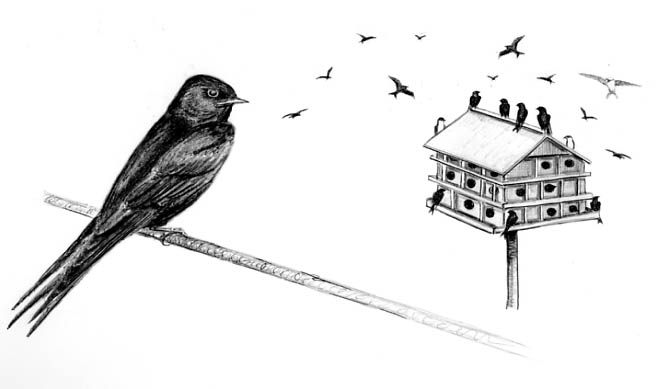
Dear Bird Folks,
I was shopping at Bowe’s Depot-mart* last week and saw that they had Purple Martin houses on sale. I was going to buy one but they seemed to be a lot of work to install, not to mention that I have never seen a Purple Martin in my life. If I invest in a martin house do you think that I would actually get martins?
-Sofia, Upstate, NY
*Note: Bowe’s Depot-mart is not the name that Sofia used in her question. She actually wrote the real name of one of those cold, hideous, sprawling places that are about the size of the Pentagon. However, to prevent a misconstrued endorsement or perhaps a lawsuit, I decided to insert a pseudo name. This way no one will have any idea what kind of store we are talking about.
A Question for you Sofia,
What are you doing shopping at Bowe’s Depot-mart? Those people don’t know anything about birds. If you were to ask one of their clerks in Upstate New York, about martins, they would probably think you were talking about Billy Martin, the successful but totally psycho baseball manager who was hired and fired by the Yankees five different times. You may want to visit a specialty nature shop instead. They specialize in useful information, whereas places like Bowe’s specialize in massive asphalt parking lots.
Okay, now that I’ve finished telling you how to live your life, let me tell you a little bit about Purple Martins. Like Tree Swallows and Bluebirds, Purple Martins are “secondary cavity nesters.” Unlike woodpeckers, that dig out their own cavities, secondary cavity nesters don’t have the tools or the desire to do all that work. They simply move into an old cavity that no one else is using, replace the curtains and they are good to go. The problem for martins is that they like to breed in colonies. A single cavity or two isn’t good enough for them; they need a bunch.
Native Americans were the first ones to offer artificial nests to martins. They often used large gourds for carrying drinking water. When the empty gourds were hung up to dry out, the martins moved right in. Not wanting to drink out of anything that birds had been nesting in, the Native Americans let the birds have the gourds and instead drank out of the plastic tumblers that they had bought at the last Tupperware party.
The Native Americans, as well as the subsequent pasty Europeans, soon learned to look forward to the arrival of martins. Martins are a welcomed sign of spring, are totally enjoyable to watch and eat lots of insects. So why not offer them some affordable housing?
Should you put out a martin house Sofia? Maybe. On my travels through upstate New York I’ve seen lots of martin houses. It would be safe to assume that martins nest fairly close to your area. To verify that, contact a local bird club, Audubon Society or birding store and ask for guidance. I wouldn’t bother asking in Bowe’s.
Yes, martin houses are a bit of work. You don’t simply run out and nail one to a tree during the commercial break of the “Price is Right.” The boxes require proper planning and placement. Once you decide that martins are in your area, you need to figure out if your yard is right for martins. The good news is that martins really like people; goodness knows why. They prefer to nest within 100 feet of a house or building. Also, your yard should be fairly open, without trees too near the box.
Installation is where the fun really begins. Some of the multi-room houses require hours of assembly and the minimum fifteen foot poles often need to be anchored in cement. But hey, who doesn’t enjoy hours of assembly and mixing bags of cement? And that’s just the beginning. The more successful boxes are monitored regularly, once a week or more. Then there is the problem of keeping out the starlings and the House Sparrows. Good luck with that.
I’m not trying to talk you out of putting up a martin house Sofia. On the contrary, martin houses are critical to the bird’s survival. It is believed that the eastern subspecies of Purple Martin depends entirely on artificial nesting sights. If we took down all the boxes tomorrow, this subspecies might die out. The reason why I made putting up a martin house sound like a lot of work is because it is a lot of work and also, because you asked. But more importantly, since the species is depending upon us for its survival, we should do things right. Plus, if you do a lousy job at setting up your martin house, all of your neighbors will think that you buy your nature products at Bowe’s. Nobody wants that.